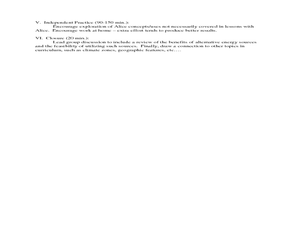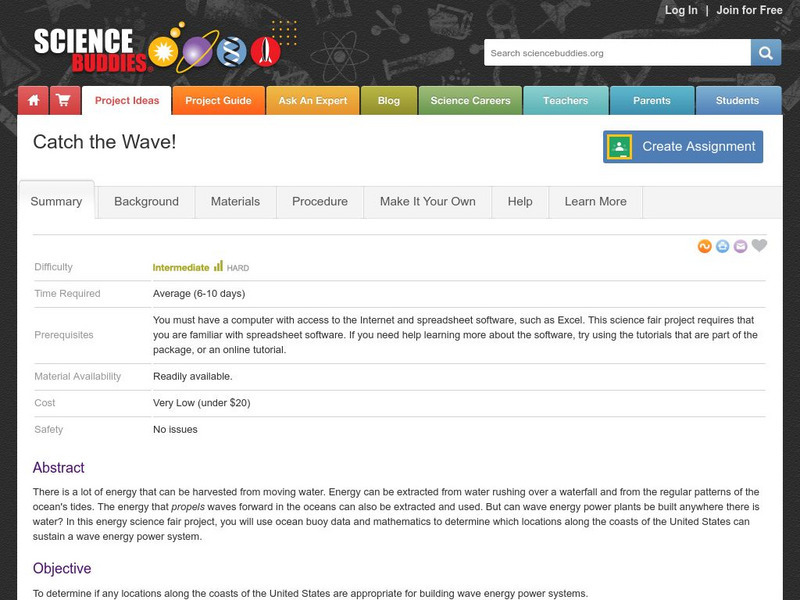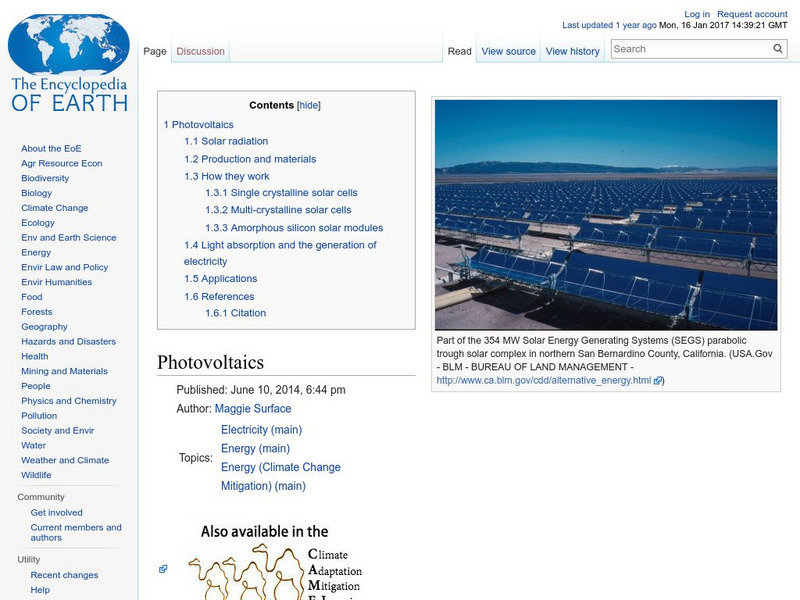Curated OER
Energy in a Clean Environment
Young scholars examine the efficiency of each alternative energy source as well as what limitations exist in terms of extracting the usable energy. They determine which energy source is most effective to the economy and the environment...
Curated OER
Language Arts: Gathering the Appropriate Information
Students are able to use the library and/or computer lab to research reliable information sources supporting arguments being put forward in the position paper. They are able to find examples of mission statements from various...
Curated OER
Energy and the Environment
Fifth graders define alternative energy form, design models which show how the energy source can be used, and explain the purpose of dams.
Curated OER
Spotlight on Photovoltaics and Fuel Cells
Learners conduct Internet research to examine the pros and cons of photovoltaics and fuel cells. They watch a web simulation on fuel cells, complete a handout, and create molecular models using pipe cleaners and gum drops.
Curated OER
Alternate Energy
Ninth graders present alternate energy sources to the class. In this alternative energy lesson, 9th graders research and present alternative energy resources to the class. They use Power Point and Alice software in their work.
Curated OER
Using Solar Energy
Students experiment to determine the effect of solar energy on the temperature of water. For this renewable resources lesson, students measure the temperature of water in a flask that is exposed to sunlight. They relate their results to...
Curated OER
Researching Alternative Energy
Sixth graders investigate the concept of energy using a hypothetical story. The power goes out in their house and they no longer can play your videogames. Students must create your own alternative power source. This story sets the stage...
Concord Consortium
Concord Consortium: Stem Resources: Wind Generator
Using a voltage sensor, students will measure how much "electricity" is produced by the wind turbine that they design and build. Students will experiment with blade designs to see which one collects energy from the wind the most...
National Academies of Sciences, Engineering, and Medicine
The National Academies: Our Energy Sources
The many sources of energy production in the United States are described in this overview. Included are traditional sources, renewable sources, and new energy production technologies.
eSchool Today
E School Today: Renewable Energy Sources
Learn what renewable energy is, the different types, and why it's important to conserve energy.
National Academies of Sciences, Engineering, and Medicine
The National Academies: What You Need to Know About Energy
This very comprehensive site aims to provide the latest, most accurate information available about energy, its consumption, sources of energy, alternative energy, impact on the environment, and conservation. One section focuses on the...
Biotechnology Institute
Biotechnology Institute: Your World: Biofuels: Energy for Your Future [Pdf]
Students can read this full-length download of the biotech magazine which discusses how biofuels could be the energy of the future, and meet all our energy needs.
PBS
Pbs Learning Media: Alternative Energy
Students are asked to explain what needs to be considered if alternative energy sources are to be used. [0:32]
Science Buddies
Science Buddies: Project Ideas: Growing Green: How to Extract Energy From Grass
In this energy science fair project, the student will experiment with three types of grasses and determine which variety yields the highest amount of biomass. The Science Buddies project ideas are set up consistently beginning with an...
Science Buddies
Science Buddies: Biodiesels: Converting Oil Into Clean Fuel
Experiment making biodiesel from different types of oil and determine which oils give the best result. This science fair project from Science Buddies, although in an abbreviated format compared to other Science Buddies experiments, gives...
Science Buddies
Science Buddies: Catch the Wave!
In this energy science fair project, the student will use ocean buoy data to determine if any locations along the coasts of the United States are appropriate for building wave energy power systems.
Science Buddies
Science Buddies: Cold Room? Heat It Up With a Homemade Solar Air Heater
Humans need food, water, and warm shelter to survive. But a lot of humans depend on fossil fuels to supply gas and electricity to heat our homes. But burning fossil fuels to create energy is harmful to the environment. In this science...
Science Buddies
Science Buddies: Waste Not, Want Not: Use the Microbial Fuel Cell to Create Elec
Gross. What is that in the toilet? But maybe it's not just gross. Did you know there are bacteria that digest organic waste and create electrons? What if there was a way to collect those electrons to power a circuit? In this science fair...
Technology Student
Technology Student: Technology and the Environment
This site focuses on alternate energy sources and how they can help us save our environment.
TryEngineering
Try Engineering: Working With Wind Energy
After studying wind energy, student teams design and test a windmill that has to meet specific criteria. Afterwards, they evaluate the success of their design and how they could improve it.
American Institute of Biological Sciences
Action Bioscience: Rethinking Fossil Fuels
Find out how fossil fuels impact the environment and cause climate change.
Encyclopedia of Earth
Encyclopedia of Earth: Noise Pollution: Wind Power
Discusses wind energy, how it is created, its history, benefits, negative effects, and what the future holds for this alternative energy source.
Encyclopedia of Earth
Encyclopedia of Earth: Energy: Solar Power
Explains what solar power is, how it is produced, its limitations as an alternative energy source, environmental issues, the importance of analyzing solar power systems on an ongoing basis, and geographical considerations. (Published:...
Encyclopedia of Earth
Encyclopedia of Earth: Photovoltaics
Article explaining what photovoltaic cells are, their role in solar energy, how they work, how electricity is produced, and applications of this technology. (Published: April 24, 2010)













![Biotechnology Institute: Your World: Biofuels: Energy for Your Future [Pdf] Article Biotechnology Institute: Your World: Biofuels: Energy for Your Future [Pdf] Article](https://d15y2dacu3jp90.cloudfront.net/images/attachment_defaults/resource/large/FPO-knovation.png)









